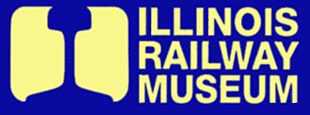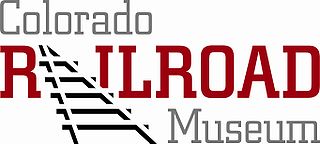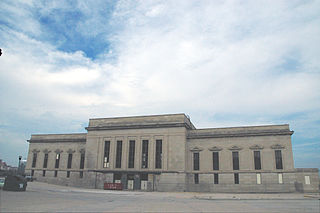The South Omaha Terminal Railway in Omaha, Nebraska was a subsidiary of the Union Stock Yards Company of Omaha. Until the separate railroad company was created in July 1927, the trackage, about 17 miles (27 km), was owned and operated directly by the Union Stock Yards Company of Omaha. On April 4, 1978, an Interstate Commerce Commission emergency service order was issued at which time the Brandon Corporation took over service.

Omaha is the largest city in the state of Nebraska and the county seat of Douglas County. Omaha is located in the Midwestern United States on the Missouri River, about 10 miles (15 km) north of the mouth of the Platte River. The nation's 40th-largest city, Omaha's 2017 estimated population was 466,893.

The Union Stock Yards Company of Omaha was a 90-year-old company first founded in South Omaha, Nebraska in 1876 by John A. Smiley. After being moved to Council Bluffs, Iowa and dissolved within a year, the company was reorganized and moved to South Omaha in 1883. Six local businessmen responded to a request by Wyoming cattle baron Alexander Swan showing interest in a livestock market closer than the Union Stock Yards in Chicago, Illinois. The Company's Union Stockyards in South Omaha were once a fierce rival of Chicago's Union Stock Yards. The Union Stock Yards Company of Omaha was bought out in 1973.

The Interstate Commerce Commission (ICC) was a regulatory agency in the United States created by the Interstate Commerce Act of 1887. The agency's original purpose was to regulate railroads to ensure fair rates, to eliminate rate discrimination, and to regulate other aspects of common carriers, including interstate bus lines and telephone companies. Congress expanded ICC authority to regulate other modes of commerce beginning in 1906. The agency was abolished in 1995, and its remaining functions were transferred to the Surface Transportation Board.
The Union Stock Yards Company of Omaha needed a separate line to run cattle to and from the Union Pacific Railroad mainline in downtown Omaha. After building the line, in 1904 the Union Stock Yards Company of Omaha was involved in a U.S. Supreme Court case against the Chicago, Burlington and Quincy Railroad entitled Union Stock Yards Company of Omaha v. Chicago, Burlington and Quincy Railroad. The case addressed liability issues after a defective freight car injured a worker. [1]

Union Pacific Railroad is a freight hauling railroad that operates 8,500 locomotives over 32,100 route-miles in 23 states west of Chicago and New Orleans. The Union Pacific Railroad system is the second largest in the United States after the BNSF Railway and is one of the world's largest transportation companies. The Union Pacific Railroad is the principal operating company of the Union Pacific Corporation ; both are headquartered in Omaha, Nebraska.

The Chicago, Burlington and Quincy Railroad was a railroad that operated in the Midwestern United States. Commonly referred to as the Burlington Route, the Burlington or as the Q, it operated extensive trackage in the states of Colorado, Illinois, Iowa, Kansas, Kentucky, Missouri, Montana, Nebraska, Wisconsin, Wyoming, and also in New Mexico and Texas through subsidiaries Colorado and Southern Railway, Fort Worth and Denver Railway, and Burlington-Rock Island Railroad. Its primary connections included Chicago, Minneapolis-St. Paul, St. Louis, Kansas City and Denver. Because of this extensive trackage in the midwest and mountain states, the railroad used the advertising slogans "Everywhere West", "Way of the Zephyrs", and "The Way West".
In law, liable means "responsible or answerable in law; legally obligated." Legal liability concerns both civil law and criminal law and can arise from various areas of law, such as contracts, torts, taxes, or fines given by government agencies. The claimant is the one who seeks to establish, or prove, liability. Claimants can prove liability through a myriad of different theories, known as theories of liability. Which theories of liability are available in a given case depends on nature of the law in question. For example, in case involving a contractual dispute, one available theory of liability is breach of contract; or in the tort context, negligence, negligence per se, respondeat superior, vicarious liability, strict liability, or intentional conduct are all valid theories of liability.
The South Omaha Railway used former CB&Q 0-6-0 steam locomotives. During World War II the railroad applied to purchase 5 diesel locomotives from the American Locomotive Company. The basis of the request was that the steam locomotives were worn out and they needed the diesel locomotives to supply meat to the war effort. The request was approved and 5 S-1 locomotives were purchased.

The American Locomotive Company, often shortened to ALCO, ALCo or Alco, designed, built and sold steam locomotives, diesel-electric locomotives, diesel engines and generators, specialized forgings, high quality steel, armed tanks and automobiles and produced nuclear energy. The American Locomotive Company was formed in 1901 by the merger of Schenectady Locomotive Engine Manufactory of Schenectady, New York, with seven smaller locomotive manufacturers.
In later years 1 locomotive sat unused in front of the sand blasting building for Nebraska Railcar in Brandon Corporation paint. The body of this locomotive now resides in a scrapyard in Council Bluffs, Iowa. The other locomotives were sold to a railroad in Kansas where they were further dispersed. 1 locomotive is preserved at the Abilene and Smokey Valley Railroad and another is preserved at the Illinois Railway Museum as Nekoosa Paper #14.

The Illinois Railway Museum is the largest railroad museum in the United States. It is located at 7000 Olson Road in Union, Illinois, 55 miles (89 km) northwest of Chicago.











